Image Details

Erich Lessing
Found in her funerary temple at Deir el-Bahri, this pink-granite statue of a seated Hatshepsut is one of the few depictions of her as a woman (compare with photo of carving depicting kneeling Hatshepsut). Her breasts are pronounced, her face beardless. However, because she wears the nemes-headdress (the piece of pleated cloth worn by kings), she would have been recognized immediately as Egypt’s ruler. This depiction of a female Hatshepsut is consistent with the feminine epithets used in her texts, such as “the female Horus,” “daughter of Ra” and “perfect goddess”—further evidence that Hatshepsut was not trying to hide her sex. Texts from her reign vacillate between feminine and masculine characterizations, referring to her as both “daughter of Ra” (sat Ra) and “son of Ra” (sa Ra).
